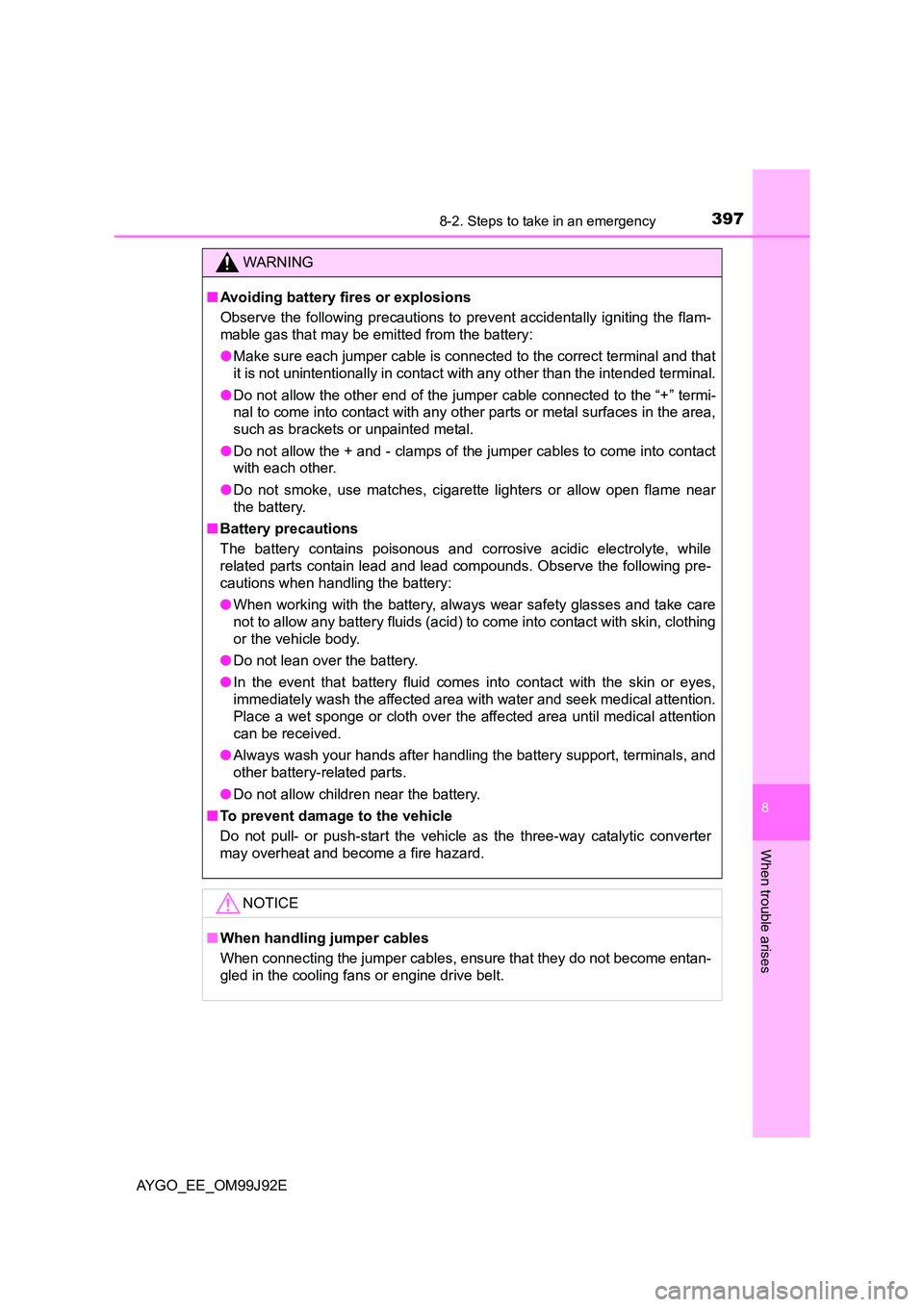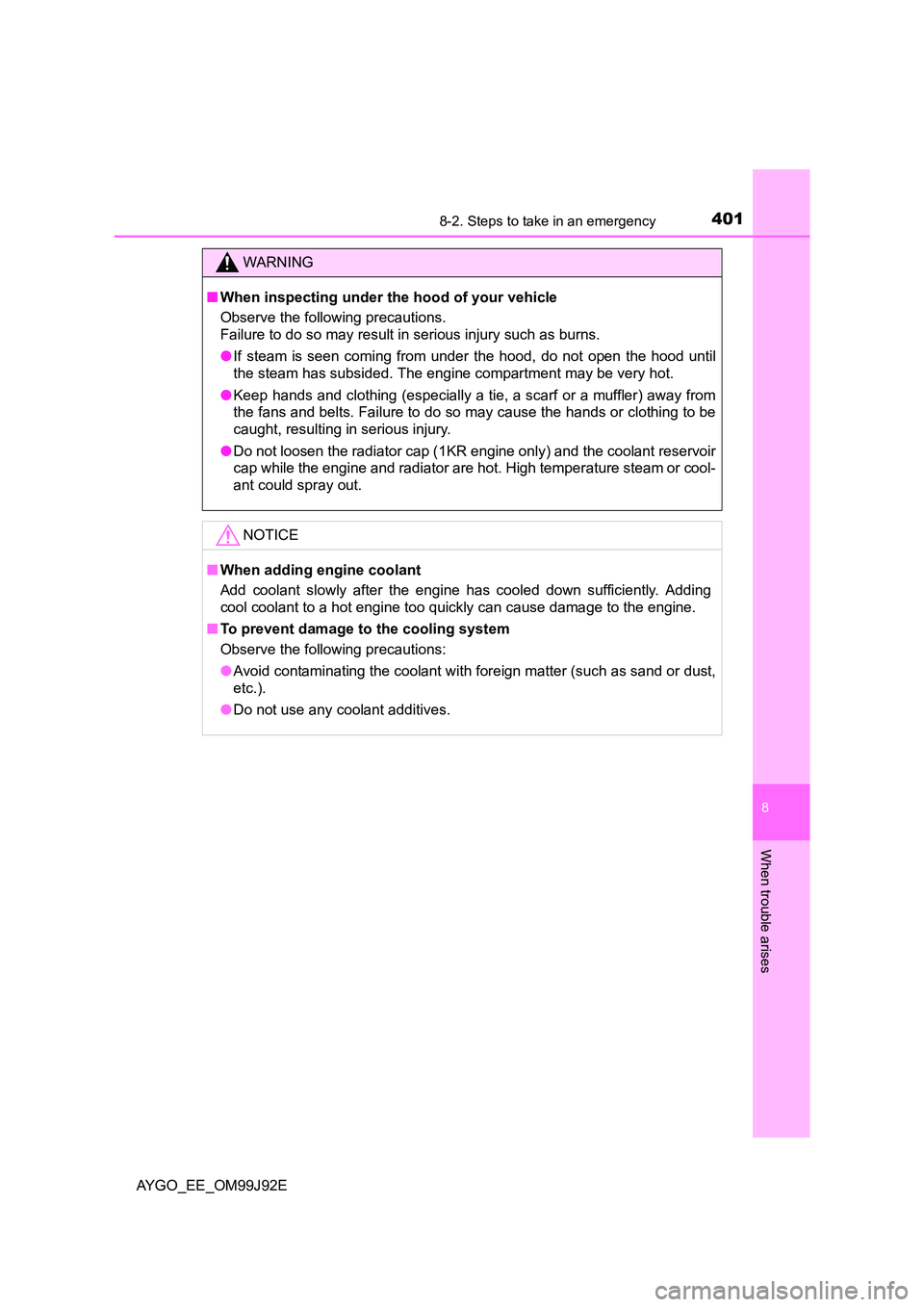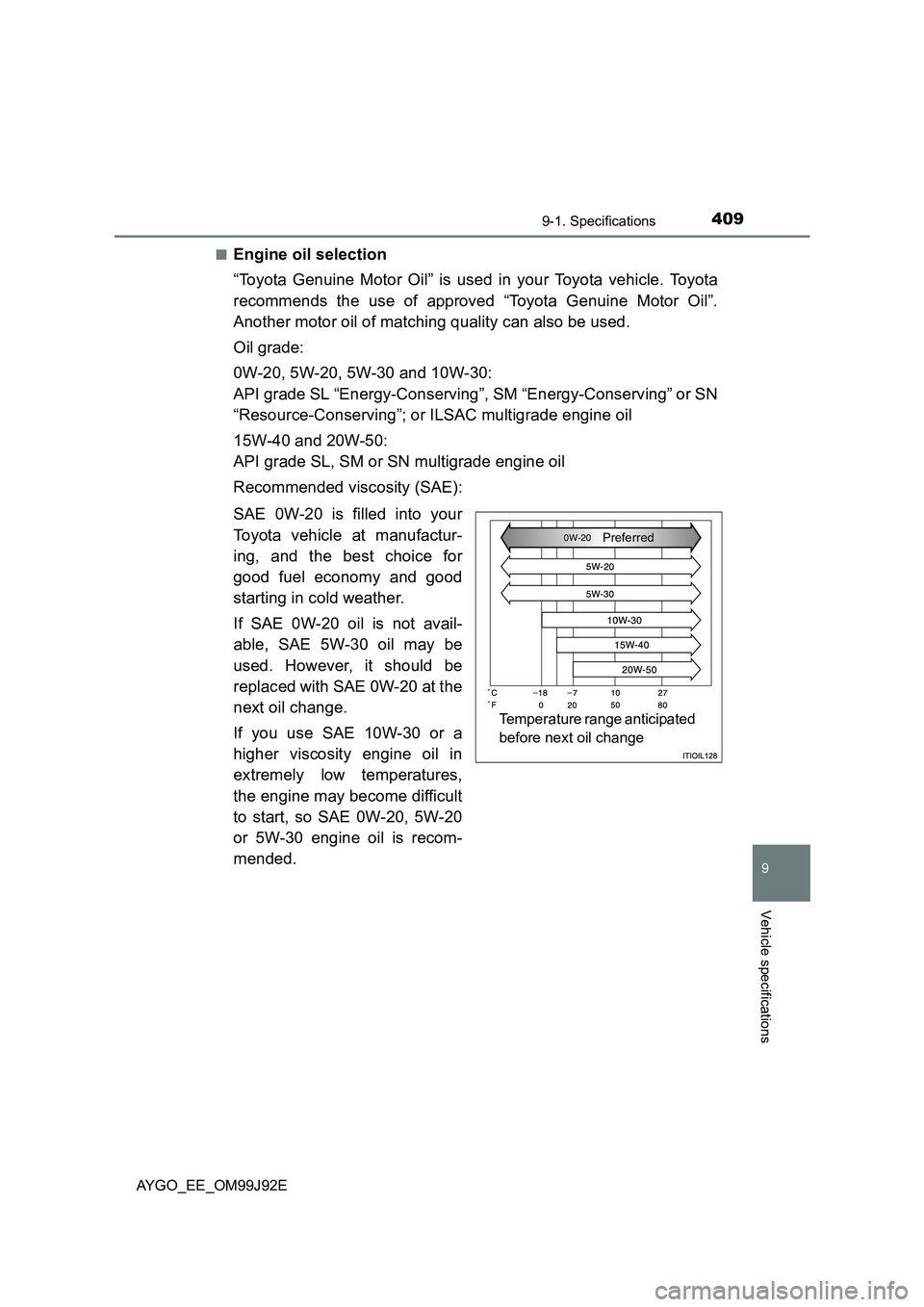Page 397 of 440

3978-2. Steps to take in an emergency
8
When trouble arises
AYGO_EE_OM99J92E
WARNING
■ Avoiding battery fires or explosions
Observe the following precautions to prevent accidentally igniting the flam-
mable gas that may be emitted from the battery:
● Make sure each jumper cable is connected to the correct terminal and that
it is not unintentionally in contact with any other than the intended terminal.
● Do not allow the other end of the jumper cable connected to the “+” termi-
nal to come into contact with any other parts or metal surfaces in the area,
such as brackets or unpainted metal.
● Do not allow the + and - clamps of the jumper cables to come into contact
with each other.
● Do not smoke, use matches, cigarette lighters or allow open flame near
the battery.
■ Battery precautions
The battery contains poisonous and corrosive acidic electrolyte, while
related parts contain lead and lead compounds. Observe the following pre-
cautions when handling the battery:
● When working with the battery, always wear safety glasses and take care
not to allow any battery fluids (acid) to come into contact with skin, clothing
or the vehicle body.
● Do not lean over the battery.
● In the event that battery fluid comes into contact with the skin or eyes,
immediately wash the affected area with water and seek medical attention.
Place a wet sponge or cloth over the affected area until medical attention
can be received.
● Always wash your hands after handling the battery support, terminals, and
other battery-related parts.
● Do not allow children near the battery.
■ To prevent damage to the vehicle
Do not pull- or push-start the vehicle as the three-way catalytic converter
may overheat and become a fire hazard.
NOTICE
■ When handling jumper cables
When connecting the jumper cables, ensure that they do not become entan-
gled in the cooling fans or engine drive belt.
Page 398 of 440
3988-2. Steps to take in an emergency
AYGO_EE_OM99J92E
If your vehicle overheats
●The high engine coolant temperature warning light (→P. 352, 353)
comes on or flashes (1KR engine); comes on (HM01 engine); or a
loss of engine power is experienced. (For example, the vehicle
speed does not increase.)
● Steam comes out from under the hood.
Stop the vehicle in a safe place and turn off the air conditioning sys-
tem, and then stop the engine.
If you see steam:
Carefully lift the hood after the steam subsides.
If you do not see steam:
Carefully lift the hood.
After the engine has cooled down sufficiently, inspect the hoses and
radiator core (radiator) for any leaks.
Radiator
Cooling fans
If a large amount of coolant leaks, immediately contact any authorized
Toyota dealer or repairer, or another duly qualified and equipped profes-
sional.
The following may indicate that your vehicle is overheating.
Correction procedures
1
2
3
�X1KR engine�XHM01 engine
1
2
Page 399 of 440
3998-2. Steps to take in an emergency
8
When trouble arises
AYGO_EE_OM99J92E
The coolant level is satisfactory if it is between the “FULL”, “F” or
“MAX” and “LOW” or “MIN” lines on the reservoir.
Radiator cap
Reservoir
“FULL” or “F”
“LOW”
Reservoir
“MAX”
“MIN”
4
�X1KR engine (type A)�X1KR engine (type B)
1
2
3
4
�XHM01 engine
1
2
3
Page 400 of 440

4008-2. Steps to take in an emergency
AYGO_EE_OM99J92E
Add coolant if necessary.
Water can be used in an emergency if coolant is unavailable.
Start the engine and turn the air conditioning system on to check
that the radiator cooling fans operate and to check for coolant leaks
from the radiator or hoses.
The fans operate when the air conditioning system is turned on immedi-
ately after a cold start. Confirm that the fans are operating by checking the
fan sound and air flow. If it is difficult to check these, turn the air condition-
ing system on and off repeatedly. (The fans may not operate in freezing
temperatures.)
If the fans are not operating:
Stop the engine immediately and contact any authorized Toyota
dealer or repairer, or another duly qualified and equipped profes-
sional.
If the fans are operating:
Have the vehicle inspected at the nearest any authorized Toyota
dealer or repairer, or another duly qualified and equipped profes-
sional.
5
�X1KR engine�XHM01 engine
6
7
Page 401 of 440

4018-2. Steps to take in an emergency
8
When trouble arises
AYGO_EE_OM99J92E
WARNING
■ When inspecting under the hood of your vehicle
Observe the following precautions.
Failure to do so may result in serious injury such as burns.
● If steam is seen coming from under the hood, do not open the hood until
the steam has subsided. The engine compartment may be very hot.
● Keep hands and clothing (especially a tie, a scarf or a muffler) away from
the fans and belts. Failure to do so may cause the hands or clothing to be
caught, resulting in serious injury.
● Do not loosen the radiator cap (1KR engine only) and the coolant reservoir
cap while the engine and radiator are hot. High temperature steam or cool-
ant could spray out.
NOTICE
■ When adding engine coolant
Add coolant slowly after the engine has cooled down sufficiently. Adding
cool coolant to a hot engine too quickly can cause damage to the engine.
■ To prevent damage to the cooling system
Observe the following precautions:
● Avoid contaminating the coolant with foreign matter (such as sand or dust,
etc.).
● Do not use any coolant additives.
Page 402 of 440

4028-2. Steps to take in an emergency
AYGO_EE_OM99J92E
If the vehicle becomes stuck
Stop the engine. Set the parking brake and shift the shift lever to N.
Remove the mud, snow or sand from around the stuck tire.
Place wood, stones or some other material to help provide traction
under the tires.
Restart the engine.
Shift the shift lever to E, M or R (vehicles with a multi-mode manual
transmission) or 1 or R (vehicles with a manual transmission) and
release the parking brake. Then, while exercising caution, depress
the accelerator pedal.
■ When it is difficult to free the vehicle (vehicles with a VSC system)
Press to turn off TRC.
Turn off TRC and/or VSC if these functions are hampering your attempts to
free the vehicle. ( →P. 192)
■ Emergency hooks
Carry out the following procedures if the tires spin or the vehicle
becomes stuck in mud, dirt or snow:
When your vehicle becomes stuck and
cannot move, the emergency hooks are
used for another vehicle to pull your
vehicle to pull your vehicle out in an
emergency.
Your vehicle is not designed to tow
another vehicle.
1
2
3
4
5
Page 408 of 440
4089-1. Specifications
AYGO_EE_OM99J92E
�X1KR engine
*: The engine oil capacity is a reference quantity to be used when changing
the engine oil. Warm up and turn off the engine, wait more than 5 minutes,
and check the oil level on the dipstick.
Fuel
Fuel type
EU area:
Unleaded gasoline conforming to European stan-
dard EN228 only
Except EU area:
Unleaded gasoline only
Research octane
number95 or higher
Fuel tank capacity
(Reference)35 L (9.2 gal., 7.7 Imp.gal.)
Lubrication system
Oil capacity
(Drain and refill Reference*)
With filter2.8 L (3.0 qt., 2.5 Imp.qt.)
Without filter2.6 L (2.7 qt., 2.3 Imp.qt.)
Page 409 of 440

4099-1. Specifications
9
Vehicle specifications
AYGO_EE_OM99J92E
■Engine oil selection
“Toyota Genuine Motor Oil” is used in your Toyota vehicle. Toyota
recommends the use of approved “Toyota Genuine Motor Oil”.
Another motor oil of matching quality can also be used.
Oil grade:
0W-20, 5W-20, 5W-30 and 10W-30:
API grade SL “Energy-Conserving”, SM “Energy-Conserving” or SN
“Resource-Conserving”; or ILSAC multigrade engine oil
15W-40 and 20W-50:
API grade SL, SM or SN multigrade engine oil
Recommended viscosity (SAE):
SAE 0W-20 is filled into your
Toyota vehicle at manufactur-
ing, and the best choice for
good fuel economy and good
starting in cold weather.
If SAE 0W-20 oil is not avail-
able, SAE 5W-30 oil may be
used. However, it should be
replaced with SAE 0W-20 at the
next oil change.
If you use SAE 10W-30 or a
higher viscosity engine oil in
extremely low temperatures,
the engine may become difficult
to start, so SAE 0W-20, 5W-20
or 5W-30 engine oil is recom-
mended.
Temperature range anticipated
before next oil change
Preferred